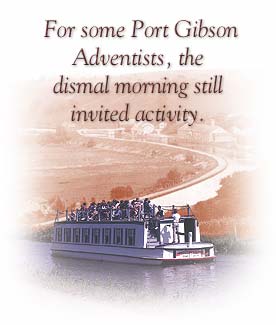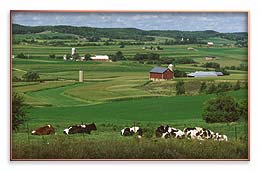But for the small group of Millerite Adventist believers on one Port Gibson farm, it was no ordinary morning, for it had been no ordinary night. Many had spent a restless night in prayer, first hopeful, then despairing, as the clock chimed midnight and then the small hours of the morning. This October morn was never supposed to dawn. By their understanding of the great time prophecies of Daniel, the world should have come to an end the previous day-October 22, 1844.
For these Adventists, October 23, 1844, was not a typical New York autumn day. As for thousands of others who had been expecting the literal return of Christ, the entire past year had been anything but typical. Unlike the previous autumns, when corn and oats had been harvested and ranks of cordwood chopped for the cold winter months ahead, they had found it hard to prepare for a winter they never expected to face. Some had been so strongly convicted of the reality of Christ's second coming that they sold their belongings. Others didn't harvest their fields or prepare at all for the season of hibernation.
While one friend walked on silently through the fields, Edson stopped to ponder what seemed to him an insight rich with meaning for disappointed Adventists. Recalling the experience years later, he wrote:
"We started, and while passing through a large field I was stopped about midway of the field. Heaven seemed opened to my view, and I saw distinctly and clearly that instead of our High Priest coming out of the Most Holy of the heavenly sanctuary to come to this earth on the tenth day of the seventh month, at the end of the 2300 days [calculated to be October 22, 1844], He for the first time entered on that day the second apartment of that sanctuary; and that He had a work to perform in the Most Holy before coming to the earth."1
Edson's understanding of what would soon come to be called "The Great Disappointment" offered discouraged Adventists a new perspective on their Millerite experience and pushed them back to study again the Bible passages that had come to be so familiar. Edson studied his new understanding of a special ministry of Jesus in the heavenly sanctuary with two area Adventists, O.R.L. Crosier and Franklin B. Hahn. Crosier, a schoolteacher, wrote an article about their new insights while staying at the Edson and Hahn homes. It was first published in a paper they called the Day-Dawn and was later reprinted in a local newspaper.2 In order to print the latter publication, Edson and his wife agreed to sell some of their wedding silverware-just the first of many sacrifices the couple would make for the cause of the Lord.
 The Day-Dawn article explained why Jesus hadn't come as expected by using Christ's parable of the wise and foolish virgins recorded in the Gospel of Matthew. Five key ideas were advanced: why the article was needed; the explanation and application of the parable; a discussion of the antitypical day of atonement; what they called "our chronology from events"; and finally, an explanation for why "the Bridegroom tarried." In addition to its special insights into biblical truth, the publication was significant because it illustrated that these Adventist believers thought of Bible truth as progressive. They were willing to receive new biblical truth, but only after studying and investigating the claims for themselves.
The Day-Dawn article explained why Jesus hadn't come as expected by using Christ's parable of the wise and foolish virgins recorded in the Gospel of Matthew. Five key ideas were advanced: why the article was needed; the explanation and application of the parable; a discussion of the antitypical day of atonement; what they called "our chronology from events"; and finally, an explanation for why "the Bridegroom tarried." In addition to its special insights into biblical truth, the publication was significant because it illustrated that these Adventist believers thought of Bible truth as progressive. They were willing to receive new biblical truth, but only after studying and investigating the claims for themselves.
Neglected Truth
Almost simultaneously, other Millerite Adventists hundreds of miles to the east were gathering around another neglected Bible truth. A Seventh Day Baptist woman, Rachel Oakes, of Verona, New York, had first taught an understanding of the seventh-day Sabbath to Adventist believers in Washington, New Hampshire, in 1844. A leading Millerite speaker, Joseph Bates, had early adopted the Sabbath after a visit to Washington and by the fall of 1846 proposed a get- together to share the news of the seventh-day Sabbath with Edson, Crosier, and Hahn. Their insights about the heavenly sanctuary had spread through the ranks of the disappointed. The location chosen for the conference was Edson's barn on his Port Gibson farm.
The meeting at Edson's rustic barn proved to be a pivotal one for the believers who within 20 years identified themselves as "Seventh-day Adventists," even though the actual date of the historic conference is now unknown. Sabbathkeeping Adventists for the first time met and fellowshipped with those possessing a new understanding of the reason for their great disappointment. Hiram Edson, upon hearing about the Bible Sabbath, immediately adopted it, and kept it for the rest of his life. From this meeting he forged a close working relationship with Joseph Bates and ultimately with James and Ellen White, emerging leaders among New England Sabbathkeeping Adventists.
As these believers further investigated the biblical teaching about Christ's high-priestly role, they came to new understandings of the relationship between the 2300-year prophecy of Daniel 8:14 and what they came to call the pre-Advent judgment. Their studies of the Israelite sanctuary service and the Day of Atonement described in Leviticus led them to see that the sins that had been accumulated by God's people throughout the year were symbolically placed on Azazel, the scapegoat, to be removed from the congregation. The "cleansing of the sanctuary" described in Leviticus pointed forwarded to the time when all the sins that have been forgiven by the blood of Jesus will be placed on Satan, thus removing sin from the universe forever (Lev. 16:10 and Rev. 20:12-14). With a new appreciation for the continuing ministry of Jesus, they pictured Him as the high priest who offers atonement for sinners and investigates their claim to be His followers and be covered by His blood. The sanctuary whose cleansing figured so prominently in their expectation of Christ's coming in 1844 was actually in heaven, not on earth. While they clearly had the date right, they had been mistaken about the event until the "present truth" dawned on them that October morn.
Seven "Sabbath and sanctuary" conferences were held during 1848, the fourth in Edson's Port Gibson barn. Through these conferences many of the doctrines shared by Seventh-day Adventists were hammered out, refined, and presented to the believers.3
A Committed Giver
Hiram Edson proved to be a pivotal supporter of the emerging church. His daughter recorded that he sold sheep from his farm and gave the money to James White to help the fledgling movement. He also gladly provided his home and haymow for periodic meetings, and demonstrated with monetary means his love for his God and his burning commitment to the cause of Christ. During the 1850s Edson worked closely with Adventist leaders in uniting scattered bands of believers and organizing churches in Pennsylvania and New York.
 When the first edition of the Advent Review4 came off a press in nearby Auburn, New York, in August 1850, Edson was listed as a member of the publishing committee. Two years later, after much prayer and the promise of a short-term loan of $650 by Edson, the committee purchased a Washington hand press on which, in August 1852, the Youth's Instructor and Sabbath school lessons debuted.
When the first edition of the Advent Review4 came off a press in nearby Auburn, New York, in August 1850, Edson was listed as a member of the publishing committee. Two years later, after much prayer and the promise of a short-term loan of $650 by Edson, the committee purchased a Washington hand press on which, in August 1852, the Youth's Instructor and Sabbath school lessons debuted.
In 1858, at age 52, Edson helped to build one of the first Seventh-day Adventist churches in the world; the building he helped to construct is still open for worship every Sabbath in Roosevelt, New York. When the Roosevelt church, and later, the New York Conference, formally organized, Edson was appointed a trustee.
Never theologically trained and without the great public gifts of the many leaders with whom he associated, Hiram Edson proved to be one of the indispensable figures of Adventism's first decades. His cornfield insight into Jesus' high priestly ministry helped focus attention on forgotten Bible truth. His hospitality and generous spirit brought leaders together for pivotal Bible conferences. His financial support helped to launch both the church's publishing work and its earliest organizational structures.
The consequences of that October morn will probably never be completely known on earth. But then, it wasn't earth that Hiram Edson called our attention to, or events to happen here. Like Abraham, "he looked for a city which hath foundations, whose builder and maker is God" (Heb. 11:10). In the light of that eternal morning he will find his just reward.
_________________________
1 F. D. Nichol, The Midnight Cry, p. 458.
2 O.R.L. Crosier, "To All Who Are Waiting for Redemption," Day-Dawn, Mar. 26, 1845. In a special number of his journal, the Day-Star Extra, Feb. 7, 1846, the memorable article concerning the heavenly sanctuary and its cleansing, prepared by Hiram Edson, Franklin Hahn, and O.R.L. Crozier, was also subsequently published.
3 George Knight, A Brief History of Seventh-day Adventists, pp. 52-55.
4 One year earlier, in 1849, the first edition of Present Truth, also edited by James White, had been published in Middletown, Connecticut. This earliest forerunner of what is today the Adventist Review was merged with the Advent Review, begun in Auburn, New York, to form the foundation of what is now one of the United States's longest-published denominational magazines.
_________________________
Howard Krug is a high school history teacher and has a deep interest in early Seventh-day Adventist history. He writes from Webster, New York.

